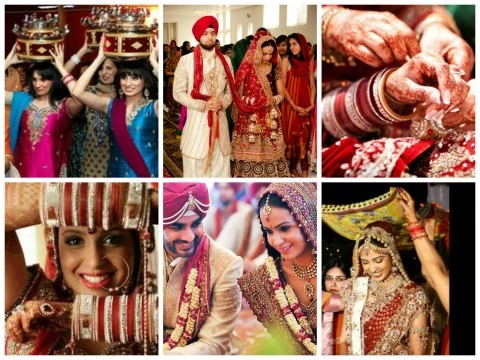
The Vibrant Symbols Of Marriage In Punjab: Tradition, Culture And Significance.
Punjab, a region known for its rich cultural heritage and vibrant traditions, celebrates marriage with a host of distinctive symbols and rituals. Punjabi weddings are renowned for their grandeur, colourfulness, and deep-rooted customs. This blog explores the key symbols of marriage in Punjabi culture, their meanings, and their significance in celebrating the union of two souls.
1. Chooda (Bride's Bangles)
a. Symbolism and Significance:
The chooda is one of the most iconic symbols of a Punjabi wedding. These are traditional bangles, often made of red and white glass or sometimes even ivory that the bride wears after her marriage. The chooda is not just a decorative accessory but a symbol of marital status and prosperity.
b. Ritualistic Role:
The chooda is typically gifted to the bride by her maternal uncle (mama) and is worn for a specific period following the wedding. It is believed to bring good fortune and protect the bride from negative influences. The process of wearing and later removing the chooda is accompanied by various rituals and blessings from family members.
2. Kara (Steel Bangle)
a. Spiritual and Cultural Meaning:
The kara is a steel bangle worn by both men and women in Punjabi culture, especially those who follow Sikhism. It symbolizes the eternal nature of God and the wearer's commitment to righteousness and justice.
b. Ritualistic Importance:
While not exclusive to weddings, the kara is an important symbol of Sikh identity and values. In the context of marriage, it represents the couple's commitment to maintaining spiritual and moral values throughout their married life.
3. Sindoor (Vermillion Powder)
a. Symbol of Marital Status:
Sindoor, or vermillion powder, is applied to the parting of the bride’s hair during the wedding ceremony. This practice signifies her transition into married life and her devotion to her husband.
b. Ritualistic Use:
In Punjabi weddings, sindoor is often applied by the groom as part of the ritual, and its application is a significant moment that marks the formal union of the couple. The bright red color of the sindoor symbolizes prosperity, love, and the auspiciousness of the marriage.
4. Mangalsutra (Sacred Necklace)
a. Traditional Significance:
The mangalsutra is a sacred necklace that symbolizes the marital bond between the bride and groom. In Punjabi culture, it is often a simple gold chain with black beads or a more elaborate design, depending on personal preference.
b. Ritual Importance:
The mangalsutra is tied around the bride’s neck by the groom during the wedding ceremony, signifying his commitment and the couple’s new journey together. This ritual underscores the significance of the union and the protection and prosperity it is believed to bring.
5. Jhumar (Forehead Ornament)
a. Cultural Adornment:
The jhumar is a traditional forehead ornament that enhances the bride’s beauty and adds a touch of elegance to her wedding attire. It is often adorned with intricate designs and precious stones, reflecting the artistry of Punjabi jewellery.
b. Symbolic Role:
The jhumar is not only a decorative piece but also a symbol of the bride’s transition into married life. It complements other bridal adornments and contributes to the overall splendor of the wedding ceremony.
6. Dupatta (Veil)
a. Symbol of Purity and Respect:
The dupatta, a long scarf or veil, is an integral part of the bride’s attire. In Punjabi weddings, the bride’s dupatta is often richly embroidered and may be draped over her head as a sign of respect and modesty.
b. Ritualistic Use:
During the wedding ceremony, the dupatta may be used in various rituals, such as the exchange of garlands or during the saat pheras (seven rounds around the sacred fire). It symbolizes the bride’s new role and her reverence for the marital bond.
7. Paan (Betel Leaves) and Areca Nut
a. Ritualistic Offering:
Paan and areca nut are often used in Punjabi weddings as part of the ceremonial offerings. They are considered auspicious and are used in various rituals to bring good luck and prosperity to the couple.
b. Symbolism:
Offering paan and areca nut to guests and during rituals signifies hospitality and the auspicious nature of the wedding. It reflects the cultural importance of these elements in celebrating the union.
8. Wedding Attire
a. Traditional Clothing:
Punjabi weddings are renowned for their vibrant and opulent attire. The bride often wears a richly embroidered lehenga or salwar kameez in bright colours, while the groom wears a sherwani or suit, often adorned with a turban.
b. Cultural Significance:
The choice of clothing reflects the joyous and celebratory nature of the occasion. The intricate designs and bright colors symbolize happiness, prosperity, and the union of two families.
Conclusion
Punjabi weddings are a celebration of culture, tradition, and joyous union, marked by a rich array of symbols and rituals. The chooda, kara, sindoor, mangalsutra, jhumar, dupatta, paan, and areca nut each hold unique meanings and contribute to the vibrancy of the wedding celebration. These symbols not only adorn the bride and groom but also reflect the deep cultural heritage and values of Punjab.
Understanding and embracing these traditions helps preserve the cultural richness of Punjabi weddings and honors the time-honored customs that have been cherished for generations. As we celebrate these symbols, we keep alive the vibrant spirit and cultural legacy of Punjab’s wedding traditions. To visit our website for get in touch Dialurban Punjab

Related Posts